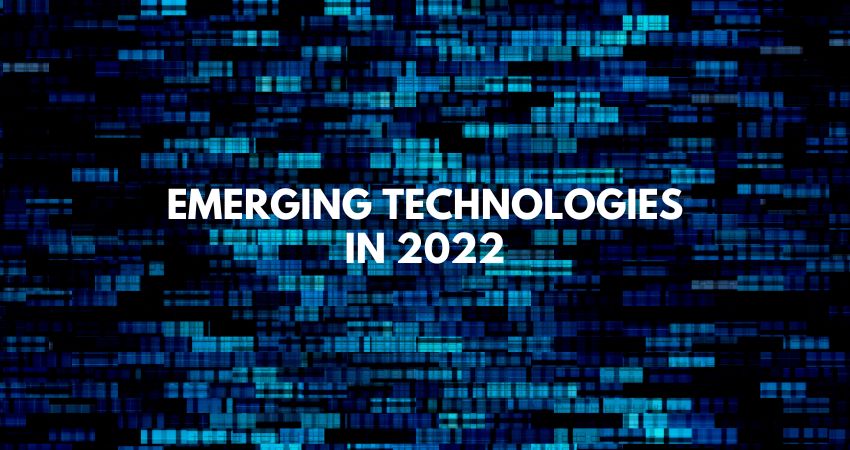Emerging Technologies in 2022
Emerging technologies are those that are in their early stages of development and are not yet widely used. They may be new and untested, or they may only be used in a small number of places and have the potential to change the way we live, work and interact. Emerging technologies may include new types of software, devices, or methods of communication. Some examples of emerging technologies include:
- Artificial intelligence (AI)
One of the most exciting emerging technologies is artificial intelligence (AI). AI is a subset of machine learning, which is a subset of data science. Machine learning is a process by which computers can learn to do tasks on their own, based on data. AI is based on the idea that computers can be made to “think” like humans. This means that they can understand complex patterns and respond intelligently to situations.
There are a number of applications for AI. For example, it could be used to improve safety in the workplace. It could help doctors diagnose diseases more accurately. It could also be used to automate tasks that are currently done by humans, such as customer service.
- Virtual reality (VR)
Virtual reality (VR) is a simulated experience that can be similar to or completely different from the real world. Applications of virtual reality include entertainment (e.g. video games), education (e.g. medical or military training), and therapy (e.g. treating post-traumatic stress disorder). VR technology is rapidly evolving and has the potential to revolutionize many industries.
There are a few different types of VR systems. The most common are head-mounted displays, which allow users to be fully immersed in the virtual environment. There are also hand-held devices, such as the Oculus Rift, that provide a more limited but still immersive experience.
VR has many potential applications. For example, it could be used to train surgeons before they operate on real patients. It could also be used to help people with anxiety disorders by exposing them to virtual situations that trigger their fear.
- Augmented reality (AR)
Augmented reality (AR) is a technology that allows users to see digital information overlaid on their real-world surroundings. AR technology can be used to display information such as maps, directions, and text. AR devices use a camera to detect objects and surfaces in the environment and then use software to create a virtual version of those objects and surfaces.
AR is a technology that superimposes computer-generated images on a user’s view of the real world, thus providing a composite view.
One of the most popular examples of AR is the mobile game Pokémon Go. In this game, players use their phone‘s GPS to track down and capture virtual creatures that appear in the real world.
AR has also been used in marketing and advertising, as a way to provide a more immersive experience for the viewer. For example, Coca-Cola used AR to create an interactive advertisement on a building in Times Square.
There are many potential applications for AR technology, and it is constantly evolving.
- 5G
5G is the fifth generation of wireless technology and is expected to provide significantly faster data speeds, reduced latency, and improved capacity compared to previous generations. 5G technology is still in development, but is expected to be deployed in select markets in near future. 5G wireless technology will enable a new class of applications and services, including immersive virtual reality, ultra-high definition video streaming, and low-latency gaming.
One of the key advantages of 5G technology is its ability to support a much denser deployment of wireless devices than previous generations. This will be critical to support the proliferation of the Internet of Things (IoT), as billions of devices are expected to be connected to the network in the coming years. 5G will also enable new applications such as real-time remote surgery and autonomous driving.
- Blockchain
One of the most important technologies currently being developed is blockchain. Blockchain is a distributed ledger that can be used to track transactions between two or more parties. This technology could have a significant impact on the way businesses operate. It could help to reduce the amount of time needed to complete transactions and could also help to ensure that transactions are reliable.
The applications for blockchain are still being developed, but there are a number of potential uses. For example, it could be used to track the ownership of assets. It could be used to secure online transactions. It could also be used to track the provenance of food products.
- Internet of Things (IoT)
The Internet of Things, also known as the IoT, is a network of physical devices, vehicles, home appliances, and other items embedded with electronics, software, sensors, actuators, and connectivity that enables these objects to connect and exchange data.
The IoT is a transformational force that is reshaping industries, economies, and societies. It is creating new opportunities for businesses and consumers, and is driving the need for new skills and capabilities.
The IoT is already having a significant impact on the way we live and work, and is expected to continue to do so in the years to come.
- Quantum computing
Quantum computing is a relatively new area of research that explores the use of quantum-mechanical phenomena to perform computation. These quantum computers are different in many ways from the computers that are in use today. For example, a quantum computer can be in multiple states simultaneously, whereas a classical computer can only be in one state at a time. This allows quantum computers to perform several operations at once. In addition, quantum computers can store and process information using quantum bits (qubits), which are units of quantum information.
There are a number of other technologies that are being developed that could have a significant impact on the future. These include blockchain technology, artificial intelligence, and virtual reality. The potential impact of these technologies is difficult to predict, but it is clear that they are having a significant impact on the development of the world economy.
Ashok Chandra
I am a technical writer who has worked on both technical and nontechnical projects. I graduated from the University of Utah with a bachelor’s degree in English.

